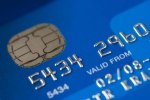Chip and PIN Technology

A Credit Card by Petr Kratochvil
Chip and PIN Technology is the new way to pay at point of sales terminals using debit and credit cards. It is based on smartcard technology; a microchip is embedded in the card. This is a group initiative by MasterCard, Visa and Europay. At the point of sales terminal, the user’s card is authenticated, i.e. ensured that the card is genuine, and after the authentication, the user must enter their personal identification number, PIN, to verify their identity at the point of sales terminal. After verification, the transaction is completed, where the user never has to hand over their card to the merchant nor are they required to sign the receipts .
Consumers can pay electronically with less fear because the card will never leave their possession when they make the payments because the consumers do not give the card to the merchant. Moreover, the consumers do not sign anything so they do not fear forgery of signatures. In addition to swiping, consumers must enter their PIN number which provides two layers of security. Earlier cards were prone to technology that had the ability to read and write data from the magnetic strip on the card which made the card prone to cloning. However, the chip is encrypted so it is very difficult to forge. Certain countries, such as France, have reporting cutting their card forging rates by 80% .
Chip and pin technology is an example of information technology that enhances privacy. This technology is protecting privacy by securing identifiable and non identifiable user information by providing two layers of protection as well as making chip replication difficult. The encryption provided by smartcard technology reduces identity theft, which allows users to shop with confidence. Similarly, the role of the signature is replaced by the PIN, which also reduces identity theft because authentication is electronic as opposed to the verification of the signature by the cashier. This type of information technology emerged from, and is dedicated to, privacy protection which ensures that it will be developed with high standards of privacy protection protocols.
Biometric Authentication

Fingerprint by Darren Lewis
Biometric authentication is a method of authenticating identity based on unique and universal physical or behavioural traits as opposed to the traditional means of identification such as providing a driver’s license or supplying a password. Some physiological characteristics used are fingerprints, retinal and iris recognition and DNA. Similarly, the behavioural traits used include voice recognition and typing rhythm. Biometric authentication employs traits that are universal, i.e. possessed by every human being, and unique, i.e. no two human beings share the same identical trait. At the moment, no single biometric authentication trait exists that is sufficient for every known application of authentication .
Biometric authentication is used for identification or verification purposes. During identification, the identity in question is compared to many of the stored identities to establish a match. During verification, the identity in question is compared with a stored copy of the data of the identity the person claims to possess .
Biometric authentication is an example of information technology that enhances privacy. If traits that contain very little sensitive biological data, such as fingerprints and voice recognition, are used to identify and verify identities, then the users do not need to worry about storage of extremely sensitive data since these traits do not contain sensitive data. For example, every human being leaves fingerprint on every item they touch. Similarly, voice recognition is an identification and verification strategy employed by ancient human beings. Furthermore this technology emerged from the need to provide security to users so privacy protection and enhancement are the goals of biometric authentication.